LA's First Municipal Power Pole
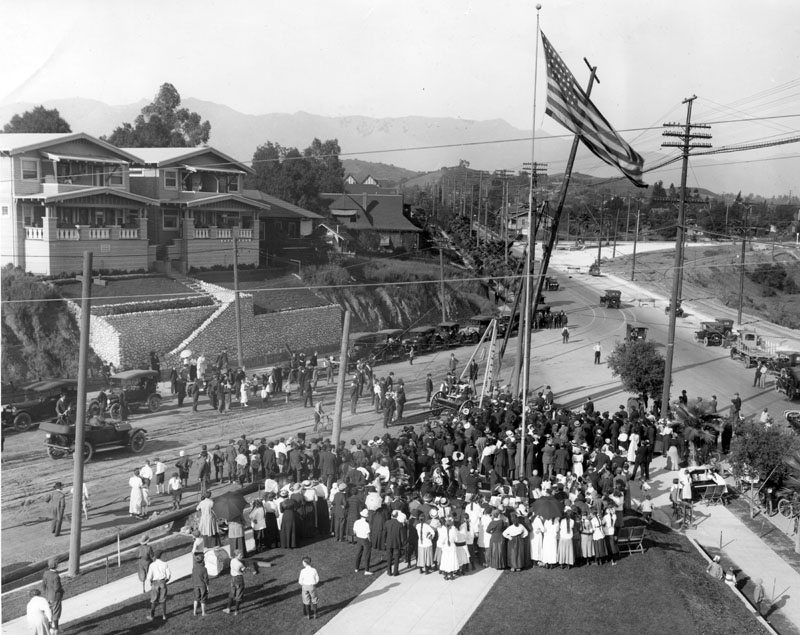 |
|
| (March 30, 1916)* - Little could the crowd that assembled at Pasadena Ave (now N. Figueroa St.) and Piedmont Avenue on March 30, 1916 know that they were seeing the start of the municipal electric distribution system that one day would be the largest city-owned electric utility in the Nation. |
1936 - LADWP Historic Archive
April 1936 – The twentieth milestone in the history of the distribution system of the municipal Power Bureau was marked last month.
On March 30, 1916, the raising of a single pole at the corner of Piedmont Avenue and Pasadena Ave (now North Figueroa Street) inaugurated a distribution system that in the short space of 20 years, under the direction of E. F. Scattergood, Chief Electrical Engineer and General Manager, not only has come to dominate the electric utility business of Los Angeles but also has grown to be the largest municipally-owned system in the United States.
After the history-making fist pole was set, rapid progress was made in erecting more poles and stringing the maze of copper wires which were to bring to residents of the city cheap, municipally-distributed electric power.
Construction headquarters were established at Avenue 59 and Piedmont Avenue, from which central location line crews operated in the Highland Park and Garvanza sections.
Four members of the crew which set the first pole still are in the employ of the Department: B. C. Booth is foreman of Overhead District No. 2; W. B. ‘Shorty’ Huebner is in the Transportation section at 1630 North Main Street; Walter Thompson is pole inspector in the Stores section; and ‘Doc’ Floyd also is with the Stores section.
First distribution of electrical energy occurred on November 13, 1916, with power purchased from the Pasadena municipal plant. San Francisquito Power Plant No. 1, the 110,000 volt transmission line and Receiving Station “A” were placed in service the following year.
That people realized the significance of this momentous event in the City’s history is evidenced by a paragraph in the Sixteenth Annual Report of the Board of Public Service Commissioners, covering the fiscal year 1916-17. The paragraph said:
| “Street lighting systems and commercial and domestic light and power systems have been built and placed in operation in two important sections of the City. This constitutes the completion of the first step in what bids fair to become the most important venture in municipal ownership in the country." |
Two years later the Board of Commissioners, in its annual report, made the following prediction:
| “Notwithstanding the fact that extension of distributing lines was very materially restricted by reason of wartime limitations, the results obtained as shown by the increase both in revenues and number of industrial plants served are such as to demonstrate that the municipal power project is destined to play a very important part in the industrial up building of Los Angeles.” |
Intensive development of the municipal distributing system was not attained in the early period because of negotiations with the Southern California Edison Company, looking to the purchase of the company’s City distribution system. Pending the determination of the purchase question, the Bureau agreed to discontinue the work of paralleling the private utility’s lines. Construction of lines was confined principally to the San Pedro and Southwest districts.
On May 16, 1922, after five years of litigation the Bureau acquired the distributing system, within the City, of the Southern California Edison Company. The purchase added to the municipal system many miles of distributing lines, several distributing stations, 110,566 light meters, and 6,516 power meters. Up to that time the Bureau had in service 18,797 light and 677 power meters.
Many interesting comparisons between the distributing system construction forces of 1916 and the present organization may be made. The original overhead construction payroll of 30 has grown to approximately 400, headed by F. C. Rotsel, general line foreman. To this figure must be added about 200 additional employees in the underground section which did not exist in the earlier days.
Underground distribution of electric energy has eliminated the need for many poles but today they number the impressive total of 103,000 as compared with the 5,375 which constituted the original system. In addition, the Bureau has a joint interest in over 21,000 poles that are used in conjunction with other utilities.
The original primary voltage was 2,200, but it soon was apparent that this was not high enough to efficiently operate the rapidly expanding system. Accordingly, Bureau engineers conducted a study to determine the most efficient voltage which could be used and decided on 6,600. This plan, however, met a snag when the telephone company refused to enter into any joint pole agreement with any utility operating at a higher figure than 5,000 volts. The Bureau then adopted the nearest standard voltage to that figure and from that time has operated its primary lines within the City at 4,600 volts, it was explained by M. O. Bolser, engineer of design in the Design and Construction Division.
From the first few miles of copper wire, the distributing system has grown into a vast city-wide network containing approximately 2,800 circuit miles of overhead low voltage lines and about 1,800 duct miles in the underground low voltage system. More than 17,000 transformers are required to supply the consumers of municipally distributed electricity.**
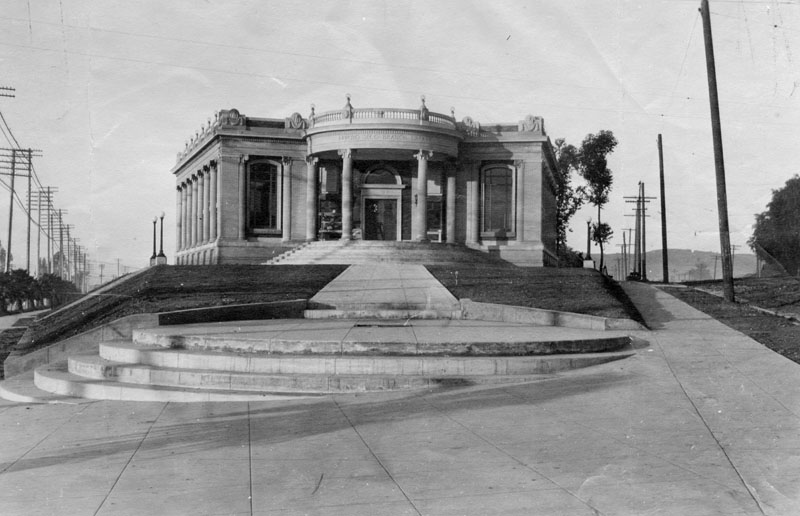 |
|
| (ca. 1916)* - Exterior view of Arroyo Seco Branch Library at 6145 North Figueroa Street. Steps and a flagpole is at the very front of the property. The pole line to the right, on Piedmont Avenue, includes the first power pole installed by the Los Angeles Bureau of Power and Light (later DWP). |
 |
|
| (ca. 1936)* - Construction crew working at the site of the first overhead power pole line in Los Angeles. |
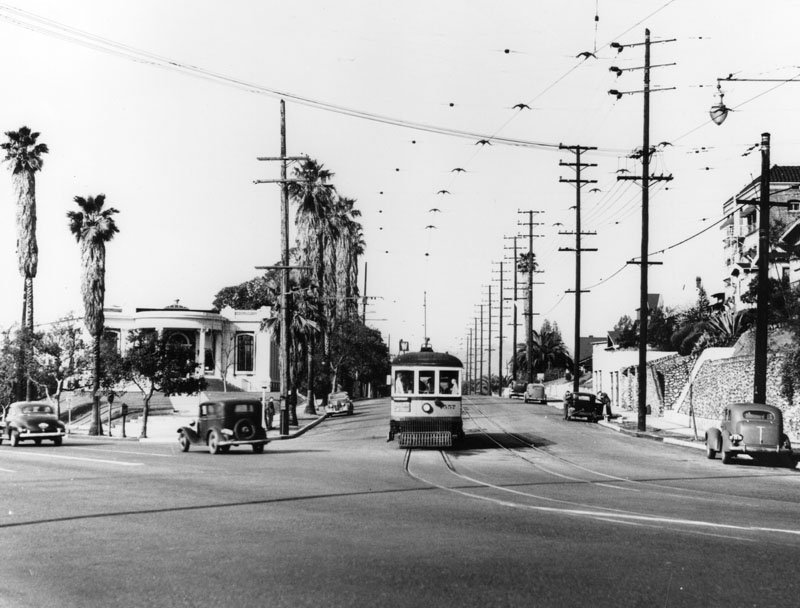 |
|
| (1946)* - View looking southwest on Piedmont Avenue, with the Arroyo Seco Branch Library on the left and a streetcar approaching the bend at N. Figueroa Street. |
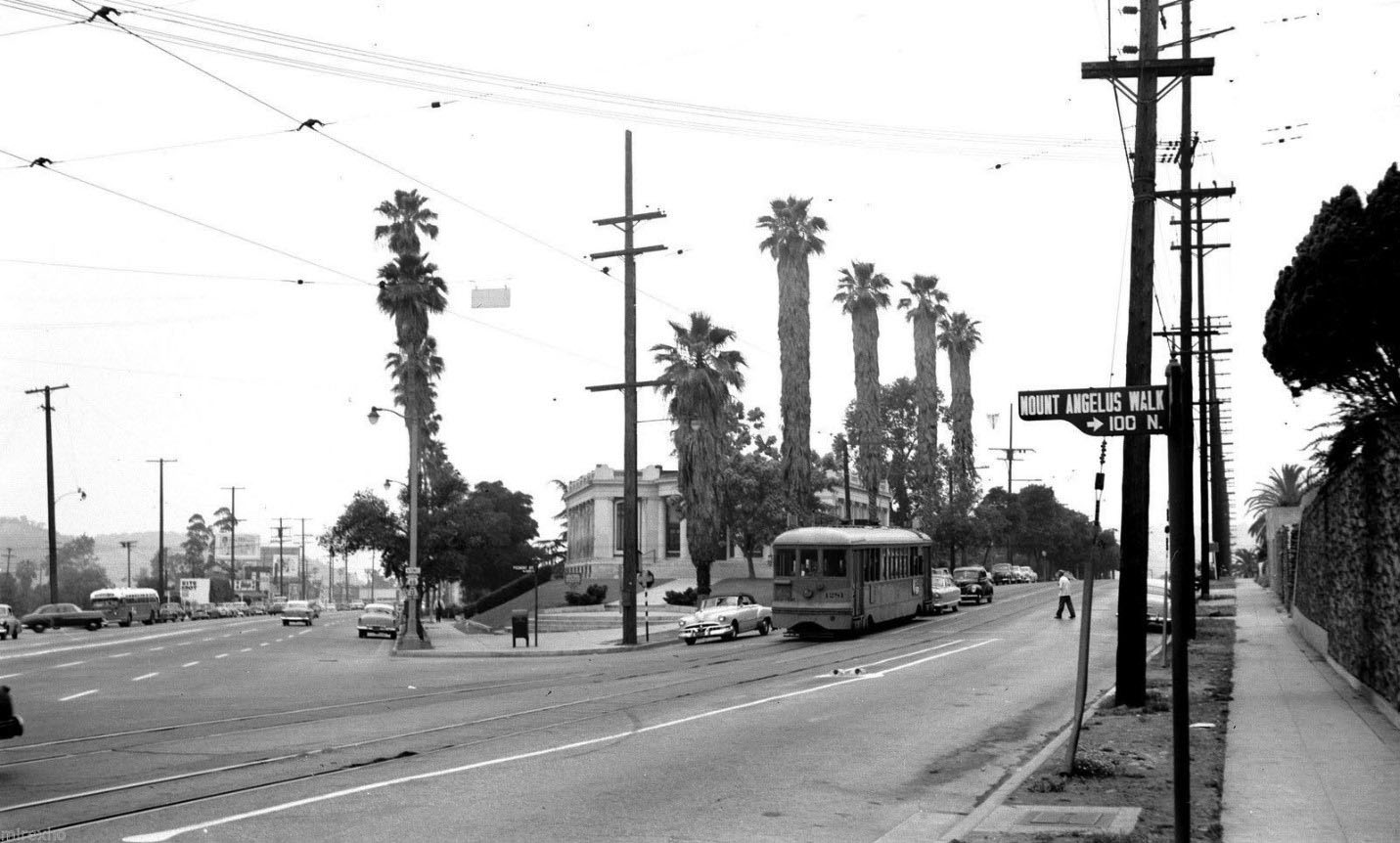 |
|
| (ca. 1951)^* – View showing Los Angeles’ First Municipal power pole standing tall on the corner of Piedmont Avenue and N. Figueroa Street. The pole appears to be lined-up with the palm trees that front the Arroyo Seco Branch Library. Sign on right reads Mount Angeles Walk which is a staired walkway that leads up to Mount Angelus Place. |
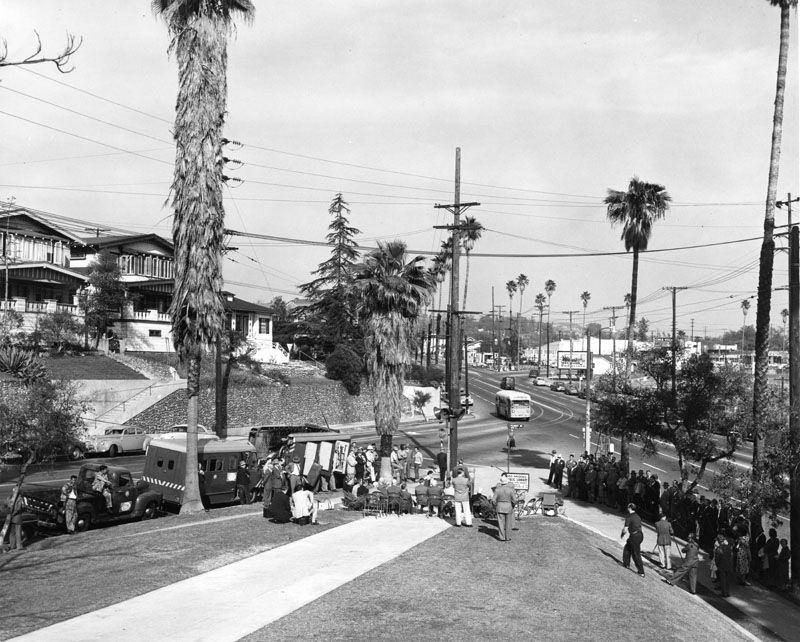 |
|
| (1952)* - Plaque placing ceremony commemorating erection Los Angeles’ First Municipal power pole in 1916 on the site of the Arroyo Seco Branch of the Los Angeles Public Library, Feb. 5, 1952. |
 |
|
| (2021)* - Plaque at the corner of corner of Piedmont Avenue and N. Figueroa Street commemorating Los Angeles’ First Municipal power pole. Photo courtesy of Los Angeles Explorers Guild. |
Historical Notes The plaque reads: “On this corner, March 30, 1916, was erected the first pole of the Municipal Electric Distribution System of the City of Los Angeles. This plaque was placed February 5, 1952, by the Department of Water and Power in commemoration of the 50th anniversary of the resumption of municipal ownership under the control of the Board of Water Commissioners. Sponsored by the Historical Society of Southern California.” |
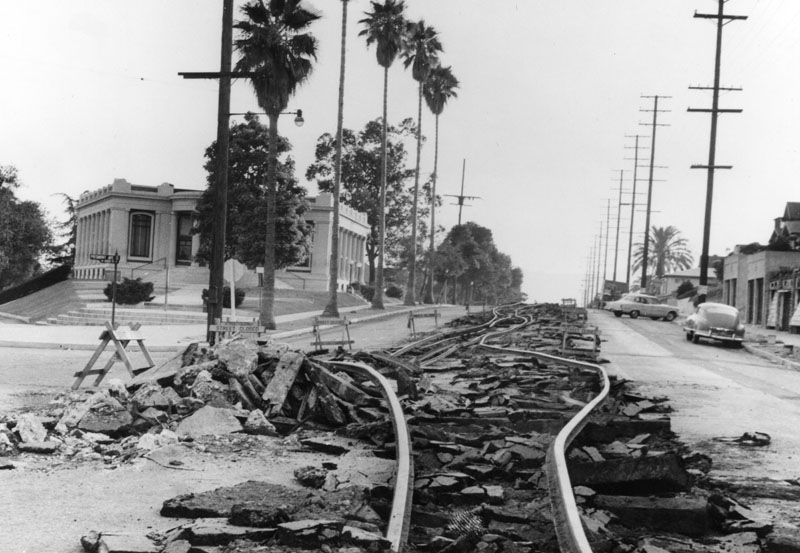 |
|
| (1958)* - View showing the old streetcar tracks being torn up on Piedmont Avenue. LADWP's first installed power pole remains standing in its original location on the corner of Piedmont Ave and N. Figueroa St. |
Historical Notes The original Classical Revival style Arroyo Seco Branch Library building was replaced by another library building in 1960 and then again in 2003. |
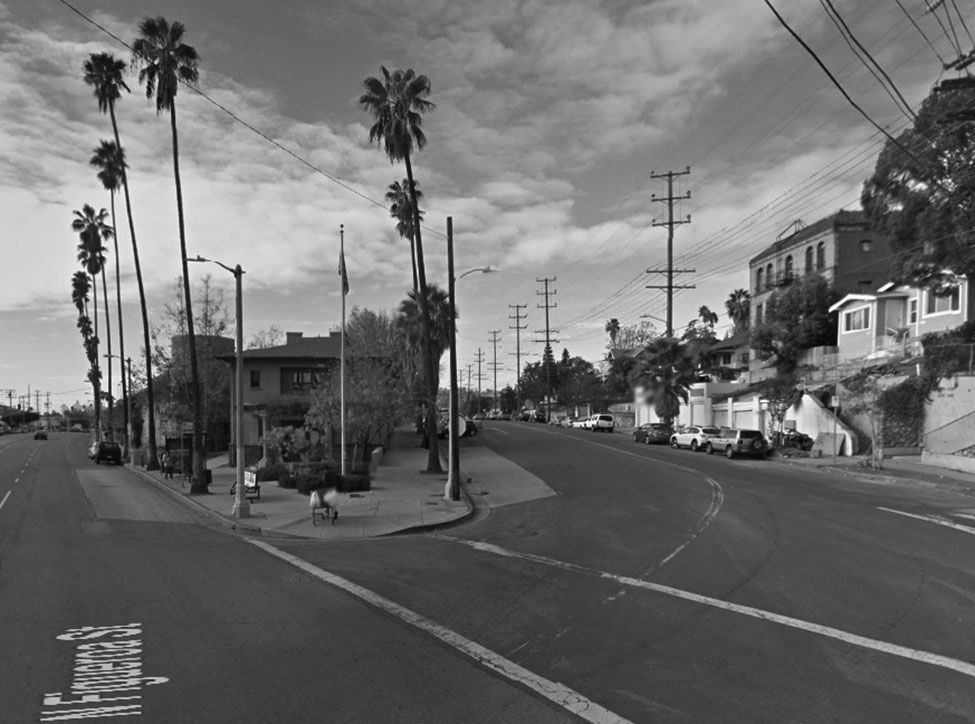 |
|
| (2016)* - View looking at the southwest corner of Piedmont Avenue and N. Figueroa Street showing LA’s First Municipal installed power pole as it appears today. Click HERE to see more in First Electricity in Los Angeles |
Then and Now
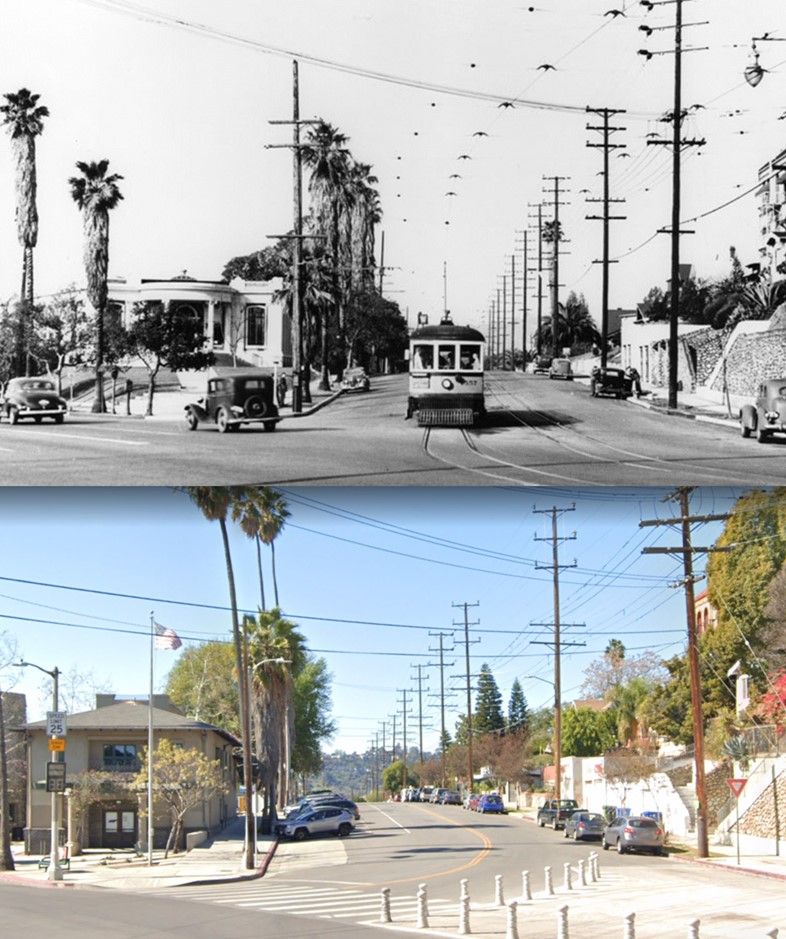 |
|
| (1946 vs. 2021)* - Looking SW on Piedmont Avenue showing a streetcar heading towards the bend at N. Figueroa Street in Highland Park. Both the old and new Arroyo Seco Branch Regional Library are seen on the left. The original 1914-built Classical Revival style Arroyo Seco Library building was replaced by another library building in 1960 and then again in 2003. Click HERE to see more. |
* * * * * |
History of Water and Electricity in Los Angeles
More Historical Early Views
Newest Additions
Early LA Buildings and City Views
* * * * * |
References and Credits
* DWP - LA Public Library Image Archive
^*The Pacific Electric Railway Historical Society (PERyHS)
< Back
Menu
- Home
- Mission
- Museum
- Major Efforts
- Recent Newsletters
- Historical Op Ed Pieces
- Board Officers and Directors
- Mulholland/McCarthy Service Awards
- Positions on Owens Valley and the City of Los Angeles Issues
- Legislative Positions on
Water Issues
- Legislative Positions on
Energy Issues
- Membership
- Contact Us
- Search Index